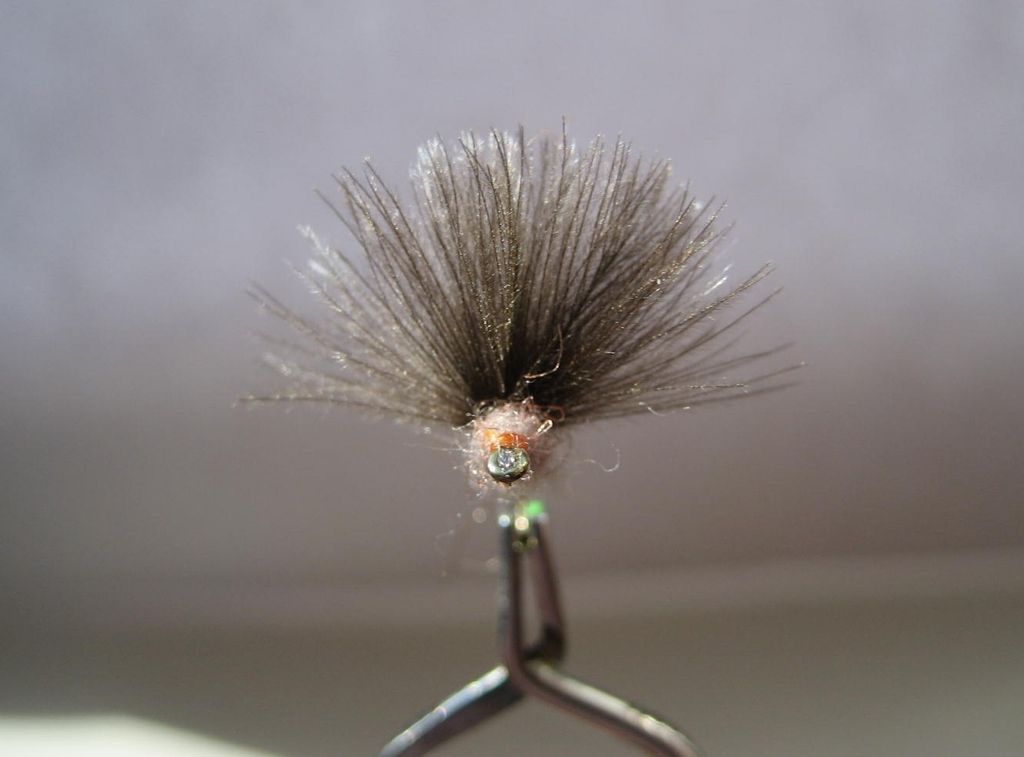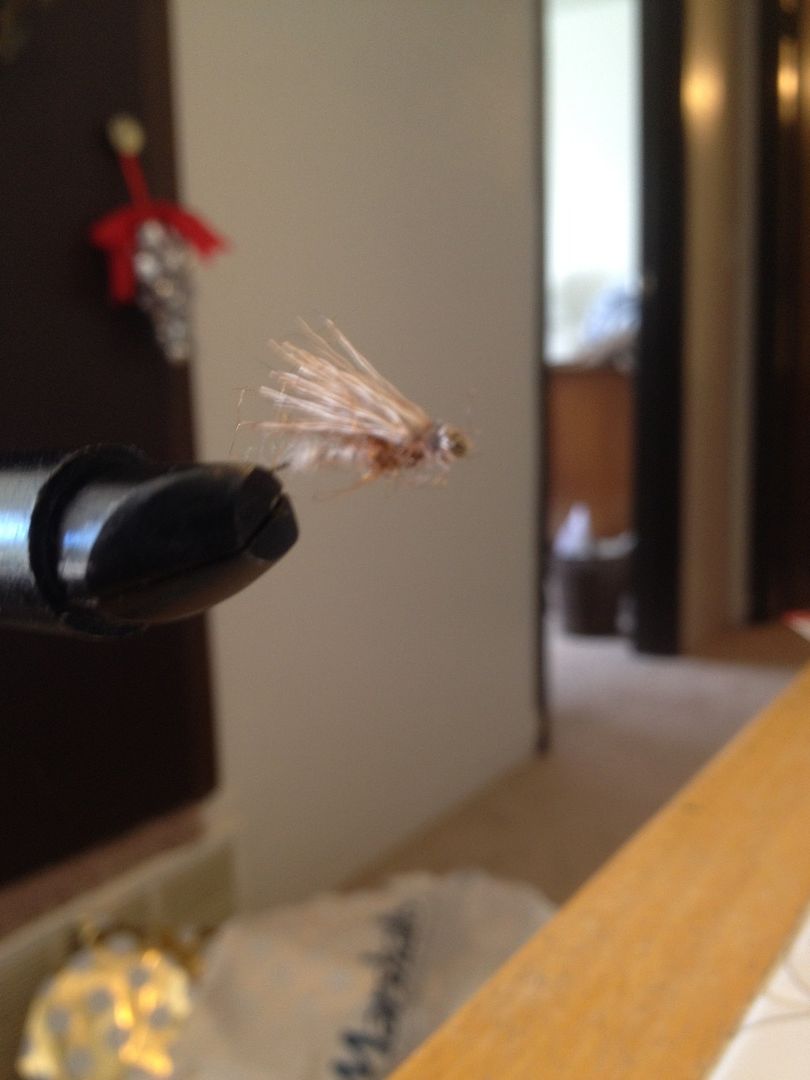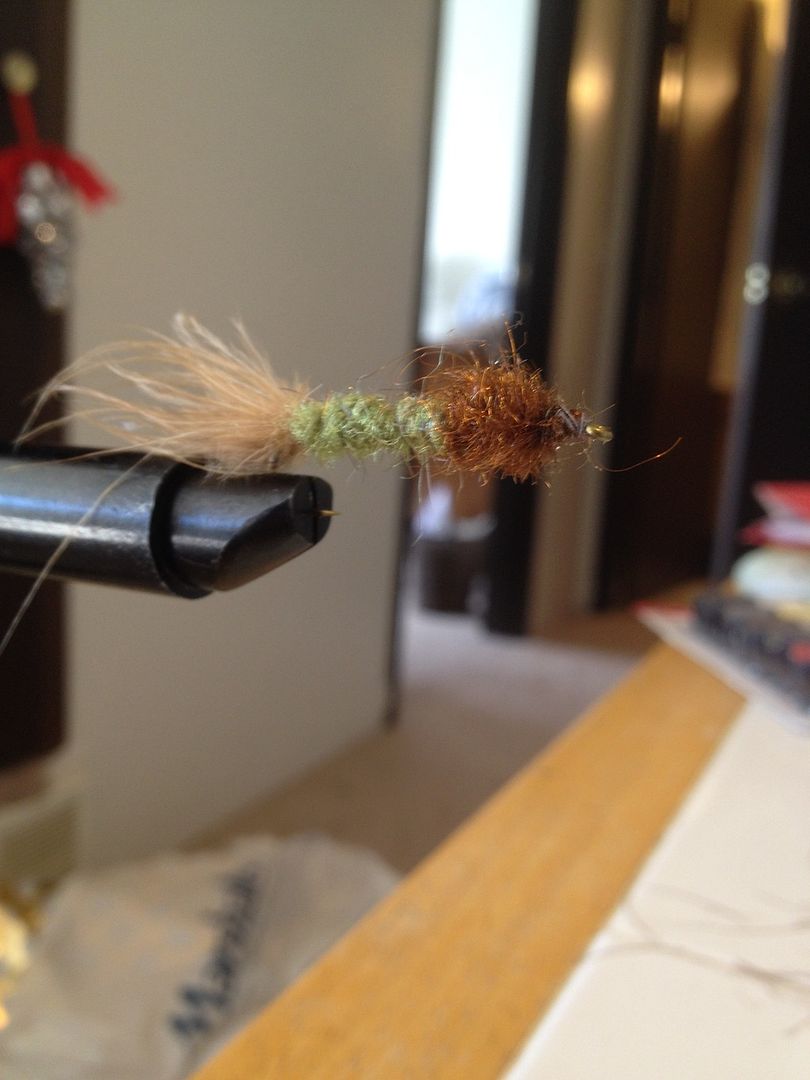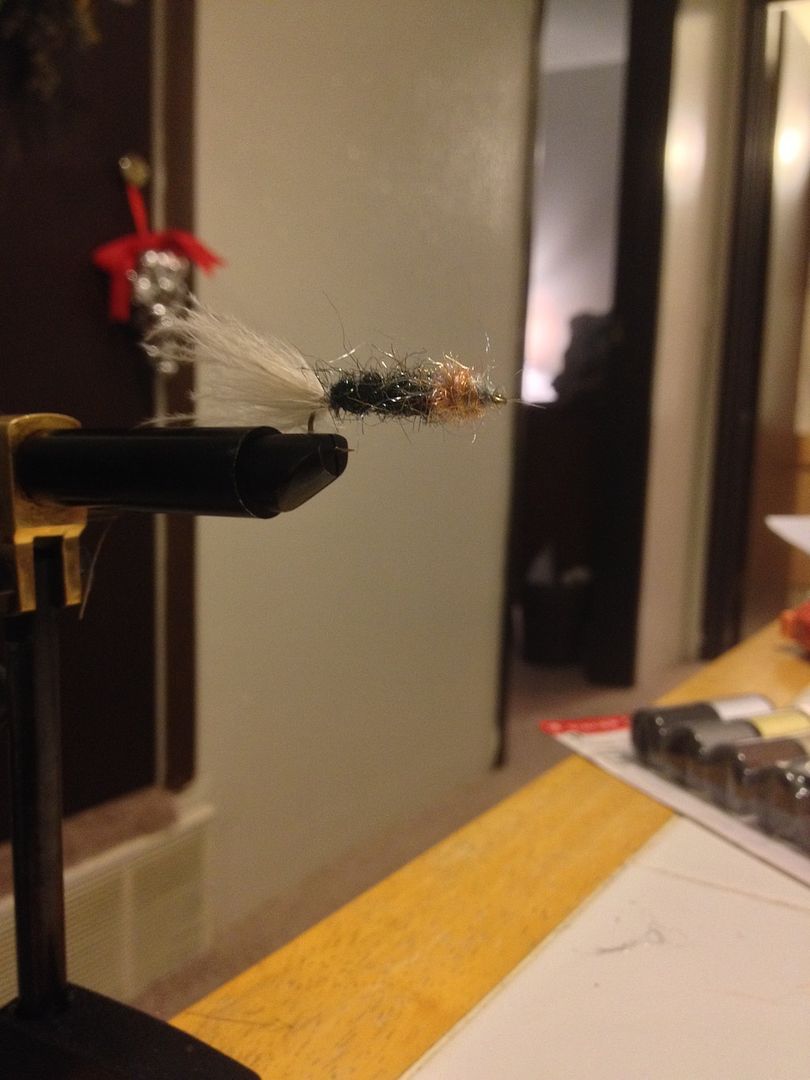Blog & Latest Updates
Fly Fishing Articles
Insects by Common Name


> > Dry fly hackle that isn't from Chickens??
| TimCat | October 30th, 2015, 7:06 pm | |
| Alanson, MI Posts: 121 | Hi all, I am about to begin fly tying this winter. My vise and a couple other materials have just arrived, still waiting for the rest of what I ordered! I don't want to start a debate about ethics, but I don't plan on ordering any chicken feathers. Let's just keep it at that, and no offense in any way to anyone either. I do however, want to tie some dry flies. I've been watching a lot of videos lately and it seems that all dry flies use rooster feathers for hackle. Is there any other feathers out there that can be used instead? I was thinking of using elk/deer hair in a dubbing loop or split thread and wrapped in front to imitate hackle. I know there are also synthetic hackles, but they seem to be used only for wet flies. Another possible alternative, may be a foam body with soft hackle, using various other natural and synthetics for the tail and wings, body, etc. I have some grouse feathers coming in the mail soon that I will be using for soft hackle. Maybe some duck, pheasant and goose feathers from a buddy who hunts too. I also have a supply on the way from my girlfriend, who is a vet student and has access to the wildlife rehabilitation center. There are a variety of birds there that always shed some feathers there (they are aware of the Migratory Birds Act and will also only be giving me legal feathers). So, the only "classic" dry patterns I think I can tie without hackle for dry flies would be the elk hair caddis and maybe some hoppers. Do any of you know about any good BWO, mayfly, or caddis patterns that don't require rooster feathers for hackle? Any ways to get around it? Can I just put a lot of float on a classic dry pattern with substituted soft-hackle? I'm fine with tying mainly nymphs, but I do want to be able to get some dry flies going. One of the most appealing things about tying your own flies is the experimentation. In the future, I will share anything I come up with that I know works too. Apparently, another good reason for me to not use rooster hackle is the price too, so I would assume, any patterns I can find/come up with could benefit others as well. Thanks in advance and any info is much appreciated. Sorry for the rambling post too. Cheers, Brandon | |
| "If I'm not going to catch anything, then I 'd rather not catch anything on flies" - Bob Lawless | ||
| Willy | October 30th, 2015, 7:30 pm | |
 Posts: 52 | Check out comparadun patterns. | |
| Check out my fishing pictures on Instagram. | ||
| TimCat | October 30th, 2015, 7:41 pm | |
| Alanson, MI Posts: 121 | Nice! I forgot about that pattern (probably because I don't have any in my box currently). Thanks for the reminder Willy. I also just came across this technique, which looks promising for a parachute style hackle substitute. http://www.flyforums.co.uk/fly-tying-step-step/26230-way-i-tie-them.html | |
| "If I'm not going to catch anything, then I 'd rather not catch anything on flies" - Bob Lawless | ||
| Taxon | October 30th, 2015, 8:25 pm | |
Site Editor Royse City, TXPosts: 1350 | Hi Brandon- Most dry fly patterns which imitate mayflies rely one (or more) rooster hackles, either wound around the hook shank (conventional style) or wound around a vertical post (parachute style). The use pf stiff rooster hackles serves to elevate the head of fly. I am not aware of any effective substitute. However, most mayfly emerger imitations are not tied with rooster hackles, and they are extremely effective when trout are feeding mayflies on the surface, which have not yet fully emerged from their nymphal shuck. Not sure why one would want to handicap oneself when trout are feeding mayflies which have fully escaped their nymphal shuck but not yet taken wing, but to each his or her own. :-) Best regards, | |
| Best regards, Roger Rohrbeck www.FlyfishingEntomology.com | ||
| Wbranch | October 31st, 2015, 6:35 am | |
| York & Starlight PA Posts: 2733 | I tie hundreds of dry flies every year and many are without rooster hackles. You can tie compara-duns as Willy mentioned with deer or elk hair wings. You can also tie compara-duns with CDC wings which is a special feather from a duck or goose. You can also tie then with synthetic fiber wings like Antron. Other dry flies not employing rooster hackles are what Swisher & Richards called "No-Hackes" or "Side Winders". These are dry flies with split tails, a tapered body, and two matched duck quill slips tied in at mid point on the hook shank in an upright position as the wings. Furthermore you can use CDC fibers to do the same, or better, job as hackles on a dry fly. You can either just wind a feather around the hook shank as you would a rooster hackle or you can cut the barbules off of the stem and put them into a dubbing loop and palmer it around the hook shank. An example of a deer hair wing compara-dun;  An example of a CDC wing compara-dun  | |
| Catskill fly fisher for fifty-five years. | ||
| Troutnut | October 31st, 2015, 7:00 am | |
Administrator Bellevue, WAPosts: 2737 | You can't find dry fly "hackle" without chicken feathers, but you can find a host of other ways to make dry flies float without traditional hackle. CDC can work well (although I always have a hard time keeping it dry), deer hair comparaduns work well, synthetic comparaduns with poly yarn instead of deer hair work just as well if not better, etc. And there are dries like foam beetles that don't involve anything hackle-like at all. So there are a lot of options for you, but no doubt you'd be giving up a useful material and a lot of other options by avoiding chicken feathers. One thing to consider, if you have ethical qualms about chicken-based hackle due to factory farming conditions, is that the roosters raised for prime dry fly hackle are probably raised under very different conditions from your typical grocery store or KFC stock. These are very specially bred animals, and the goal of keeping feathers pristine probably requires decent rearing conditions. I don't actually know anything about the conditions under which the roosters are raised, but if that's your worry, you might at least look into how these specific animals are treated rather than basing decisions on the chicken industry as a whole (if that is what you were doing). | |
| Jason Neuswanger, Ph.D. Troutnut and salmonid ecologist | ||
| Jmd123 | October 31st, 2015, 3:18 pm | |
| Oscoda, MI Posts: 2611 | Nice flies, Matt!! Jonathon | |
| No matter how big the one you just caught is, there's always a bigger one out there somewhere... | ||
| Martinlf | October 31st, 2015, 4:32 pm | |
Moderator Palmyra PAPosts: 3233 | Yes, Matt. Perfect wings on those comparaduns. I've been favoring CDC comparaduns lately. Perhaps because my biggest fish of 2015 took one. | |
| "He spread them a yard and a half. 'And every one that got away is this big.'" --Fred Chappell | ||
| Wbranch | October 31st, 2015, 4:51 pm | |
| York & Starlight PA Posts: 2733 | Thank you gentleman! Maybe one out of six comes out that nicely proportioned. I save those really pretty ones for pictures and fish the flies that are less than perfect. | |
| Catskill fly fisher for fifty-five years. | ||
| TimCat | November 1st, 2015, 11:39 am | |
| Alanson, MI Posts: 121 | Got the elk hair caddis down, but my comparadun wings are a little crooked/sparse. Ha. Last night I tied a bunch of elk-hair caddis and wooly buggers to get to practicing. By the end I got some usable ones, we'll see how they fair soon... Today I will really be giving that comparadun pattern a go. Thanks for the tips gentleman. Nice flies Wbranch. | |
| "If I'm not going to catch anything, then I 'd rather not catch anything on flies" - Bob Lawless | ||
| TimCat | November 1st, 2015, 2:11 pm | |
| Alanson, MI Posts: 121 | Ready to try out the comparadun... here's some of last night's endeavors. Elk hair Caddis  A couple of buggers   | |
| "If I'm not going to catch anything, then I 'd rather not catch anything on flies" - Bob Lawless | ||
| Crepuscular | November 2nd, 2015, 8:08 am | |
| Boiling Springs, PA Posts: 923 | TimCat, what did you use for the tails of your buggers? Turkey? | |
| TimCat | November 2nd, 2015, 12:05 pm | |
| Alanson, MI Posts: 121 | Some long under-feathers. I don't know what birds because I just got a bag handed to me from a friend who has access to a Vet School wildlife rehab center. I don't believe they have any Turkeys in there at the moment. I just plucked off long strands from the fluffy under feather part at the base of the stem, tied them in at about half way, then folded the excess back over and tied that down. I also have been doing the same thing with some marabou-ish feather-duster feathers for practice. They are on a size 8 streamer hook | |
| "If I'm not going to catch anything, then I 'd rather not catch anything on flies" - Bob Lawless | ||
| Wbranch | November 3rd, 2015, 2:54 am | |
| York & Starlight PA Posts: 2733 | Nice first tries but to be honest the essence of a Woolly Bugger besides a marabou tail is to palmer the body with a hen hackle. Since you are adverse to using chicken feathers you need to come up with a viable alternative. Try palmering marabou or grouse hackles. What you tied is more a nymph than a bugger. | |
| Catskill fly fisher for fifty-five years. | ||
| Feathers5 | November 3rd, 2015, 9:50 am | |
| Posts: 287 | Look for palmer chenile. It's sold with long fibers that can be spiraled wrapped just like hackle. | |
| TimCat | November 4th, 2015, 1:38 am | |
| Alanson, MI Posts: 121 | Thanks for the tip Feathers5. Looks a lot easier than a dubbing brush. Wbranch, I get what you mean, but I certainly wouldn't fish those like a nymph is often fished (size 8 streamer hooks). I did actually tie one with some flank feathers wrapped around the body yesterday. The fibers were a little long, but I think that might not be a problem. I guess that one would be an actual bugger then. I appreciate everybody's input and am thankful for you folks putting up with what may seem to be annoying or naive questions. | |
| "If I'm not going to catch anything, then I 'd rather not catch anything on flies" - Bob Lawless | ||
| Oldredbarn | November 5th, 2015, 6:36 pm | |
| Novi, MI Posts: 2608 | TimCat, You need a good beginner fly tying book or vid...There are books out there that explain the materials used and how to use them...To get an over view visit Charlie's Fly Box... www.charliesflybox.com Charlie Craven is a wonderful teacher...When you find his site look to the right and click 'flybox" and view some of the flies...He has material listed for eachh fly and a step by step tutorial for each one. No use walking around in the dark... Spence | |
| "Even when my best efforts fail it's a satisfying challenge, and that, after all, is the essence of fly fishing." -Chauncy Lively "Envy not the man who lives beside the river, but the man the river flows through." Joseph T Heywood | ||
| Gqualls | November 30th, 2015, 5:38 am | |
| North Carolina Posts: 1 | Another viable option would be using the hair from a snowshoe rabbit. Between snowshoe and cdc I have not tied a dry fly with any other material over the past several years. The under fur of the foot also makes great dubbing. | |
Quick Reply
You have to be logged in to post on the forum. It's this easy:
Related Discussions
| Title | Replies | Last Reply |
| round tip grizzly rooster necks In Fly Tying by Delablobbo | 0 | |
| Re: Help identify this...dragonfly? In the Identify This! Board by Fallen513 | 6 | Nov 4, 2011 by Dinerobyn |
| Re: Featherless Recipes that Work? In Fly Tying by FisherOfMen | 14 | Jan 10, 2012 by Wbranch |
| Re: International Fly Tying Symposium In Fly Tying by Shawnny3 | 6 | Nov 20, 2009 by CaseyP |
| Re: Darn Caddis Eating Fish In General Discussion by Martinlf | 4 | Apr 29, 2014 by PaulRoberts |
| Re: Turkey Feathers In Fly Tying by GldstrmSam | 3 | Sep 24, 2012 by GldstrmSam |
| Re: Beadin the bugs In Fly Tying by Sayfu | 2 | Apr 5, 2015 by Lastchance |
| Re: CDC winged dun In the Photography Board by Wbranch | 6 | Jun 9, 2017 by TimCat |
| Re: imitation? In Cheumatopsyche Caddisfly Pupa by Flytyer0423 | 4 | Oct 5, 2012 by Sayfu |
| Re: Dark Hendrickson wings In Fly Tying by Roguerat | 5 | May 9, 2013 by Roguerat |
Troutnut.com is copyright © 2004-2024 Jason
Neuswanger (email Jason). See my FAQ for information about use of my images.
 privacy policy
privacy policy








